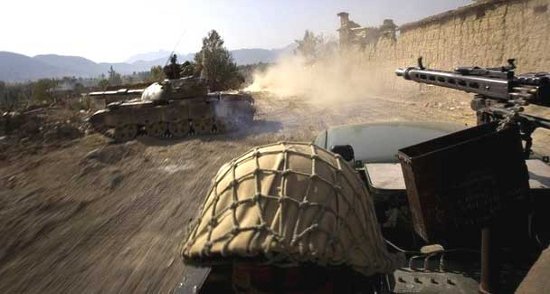Pakistan and COIN

Over at the New America Foundation, Sameer Lalwani has produced what I think is the best assessment out there on the problems in Pakistan's northwest and the Pakistani military's ability to counter the threat. Lalwani's paper is titled "Pakistani Capabilities for a Counterinsurgency Campaign: A Net Assessment" [PDF format].
A read of the summary findings from the executive summary shows Lalwani grasps the complexity and scope of the problem, and the physical limitations of the Pakistani government and security establishment in waging an effective counterinsurgency.
Pakistan has deployed too few troops and won't move more from the Indian border, is using conventional and not counterinsurgency techniques, has relied on negotiations with the Taliban, and does not perceive the Taliban as an existential threat. The government has little capacity to provide for extended economic development and has political obstacles in relying on the US and West for aid. The terrain favors the Taliban. Don't just stop at the executive summary, the full report is well worth the read. And there are some good maps in there, including one from The Long War Journal.
The main points from the executive summary are quoted below:
1. Shortfalls. Between 370,000 and 430,000 more troops would be needed in the FATA and the NWFP region to meet the minimum force-to-population ratios prescribed by counterinsurgency (COIN) doctrine, much higher than current Pakistani deployments of 150,000, and even this is no assurance of success given adverse conditions. Moreover, Pakistan now is conducting low-intensity warfare rather than using counterinsurgency tactics, partly a function of its military doctrine.2. Too Big for the Army Alone. Troop numbers required for a COIN campaign in the NWFP and the FATA would necessitate the calling up of Pakistani reserves or the extensive use of lesser-trained and more poorly equipped paramilitary and irregular forces, including the Frontier Corps.
3. Troops Able to be Released From Indian Border. Based on threat perceptions and baseline principles of force-to-force or force-to-space ratios, the Pakistani military likely would release, at most, 207,000 from its Indian border, 55,000 of whom already have been deployed to the tribal theater. Given organizational resistance and absent a steep escalation of the threat, it is highly unlikely that Pakistan would redeploy the additional 152,000 troops to the tribal areas for a COIN operation.
4. Time Frame and Force Composition. The most optimistic time frame for raising and training the requisite forces for a counterinsurgency would be two to five years.
....
6. Terrain Disadvantages. The demographic and topographic terrain of the FATA and the NWFP are ideal for a protracted insurgency and require higher than average force ratios and far more military assets than Pakistan possesses.
7. A Distant Development Agenda. Even piecemeal development in the region would be questionable, given the realities of the Pakistani economy. More fundamentally, reform would require undermining the power of the country's existing elites and land-owning classes, which dominate the political scene.
8. A Strategic Catch-22. Pakistan's limited resources would necessitate substantial U.S. and Western military aid, assistance in training, and economic support to wage a capital-, labor-, and time-intensive COIN campaign. However, as the U.S. role expands and becomes more visible, Pakistan likely would face a stiff public backlash, a steep decline in the morale of its regular and irregular forces, and a more cohesive insurgency.
9. Needed: An Exogenous Shock. Without substantial change in its threat perceptions of the Taliban or India or new inducements from the United States and NATO, the Pakistani military probably will take a default position on the tribal areas, clearing out extremist elements of the Taliban using current tactics while seeking to cut deals with more moderate elements in the hope that those elements could take control. It would draw on standard divide-and-rule tactics and perhaps on the lashkars. While this approach might stem attacks on Pakistan, it would not end cross-border raids or support of the Taliban's Afghanistan insurgency.
